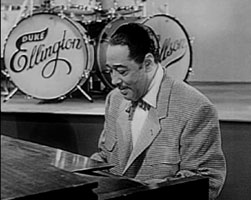 Mediocre comic Willie Bryant introduces the Rock 'n' Roll Review (1955). Very little of this film could be mistaken for rock 'n' roll. Some could, but not the majority. Doesn't matter. R & B is either just as good, or better, & we're about to see some great performances. Mediocre comic Willie Bryant introduces the Rock 'n' Roll Review (1955). Very little of this film could be mistaken for rock 'n' roll. Some could, but not the majority. Doesn't matter. R & B is either just as good, or better, & we're about to see some great performances.
This feature film release is made up of Snader telescriptions circa 1951, with new acts filmed by Studio telescription in 1954 together with Willie Bryant's emceeing, in which he pretends throughout that this is a live concert.
The individual components of the film were indeed filmed live, the newer bits on a small Studio Films sound stage midtown Manhattan, the Snaders filmed in Hollywood three or four years earlier. Neither the Manhattan nor the Hollywood performances were done in front of an audience, the sound of which the 1955 film adds, with occasional cuts to to stock footage of the imagined audience.
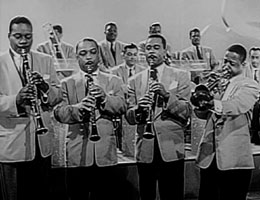 The first act Willie introduces is Duke Ellington, a Snader telescription of The Mooche (1952; on the original Snader release, the title card mispells this The Mooch). This is a unique arrangement of what was for Duke an often-redone classic instrumental in honor of New Orleans. The first act Willie introduces is Duke Ellington, a Snader telescription of The Mooche (1952; on the original Snader release, the title card mispells this The Mooch). This is a unique arrangement of what was for Duke an often-redone classic instrumental in honor of New Orleans.
The lingering camera shots of some of Ellington's band members are great, giving us close looks at the genius of Duke's crew in action, including a soft & cool transitional moment from one of the clarinetists (I think it's Harry Carney), Willie Smith on sax, fantastic trumbone moment by Butter Jackson, & the fabulous drummer Louis Bellson.
Later in Rock 'n' Roll Review Duke Ellington will return with The Hawk Talks (1952) with a Bellson drum solo rock drummers could learn by. Bellson composed this number specifically to highlight his decided ability.
Both these Snader Telescriptions were also included in the compilation Showtime at the Apollo: Review in Rhythm. (1955), along with the Larry Darnell & Dinah Washington Studio telescriptions, & the Nat King Cole Snader.
These performances are also in circulation in their original Snader releases as separate mini-movies, with their own title cards in front. Those versions don't have the intrusions of Willie Bryant, & other small re-edits to give the illusion of an Apollo Theater concert. See the reviews of all the other Ellington telescriptions.
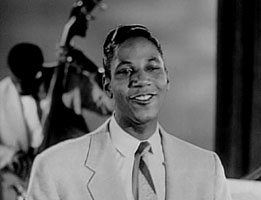 After Ellington's first number, Willie introduces Larry Darnell, an absolutely wonderful & handsome young cool jazz singer performing What More Do You want me To Do with the Paul Williams Band accompanying. Any fragment of the film with Paul Williams was recorded new at Studio Films, filmed during 1954. After Ellington's first number, Willie introduces Larry Darnell, an absolutely wonderful & handsome young cool jazz singer performing What More Do You want me To Do with the Paul Williams Band accompanying. Any fragment of the film with Paul Williams was recorded new at Studio Films, filmed during 1954.
Time-wise (for 1954) Darnell really does show a movement or motion that was occurring in 1954/55 in merging the Nat King Cole type of jazz into rhythm 'n' blues verging on the new rock 'n' roll.
Darnell took his style out of New Orleans. At the height of his popularity he was known in black communities across America as "Mr. Heart & Soul." It's a great thrill to see his performance captured live.
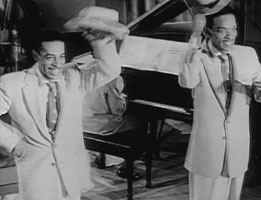 "Coles & Atkins" are third up, with Paul Williams' combo accompanying Charles "Honi" Coles & Cholly Atkins. "Coles & Atkins" are third up, with Paul Williams' combo accompanying Charles "Honi" Coles & Cholly Atkins.
These guys were a tap dance team who'll make you wonder why tap is no longer fundamental to entertainment. In their white suits & saddle shoes they're elegant as can be.
Since Coles & Atkins were filmed specifically for this film, & were never separate telescriptions, they're actually able to interact with Willie.
After their dance number, they do a bit of tough-guy comedy with Willie, resulting in a cute three-guy dance routine which has grace & humor.
Willie frankly was a terrible comic & barely capable host, but Coles & Atkins are real team players & make even Willie look good.
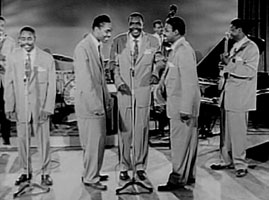 And now The Clovers come center stage to sing Your Cash Ain't Nothin' but Trash (1954), a top-ten R & B chart hit in '54, with new group member Billy Mitchell the lead tenor. And now The Clovers come center stage to sing Your Cash Ain't Nothin' but Trash (1954), a top-ten R & B chart hit in '54, with new group member Billy Mitchell the lead tenor.
They're a fine vocal group, with one electric guitarist at the side. They were extremely popular in their day, with more charting hits than any other vocal group of the time.
The Paul Williams band performs minimally & quietly in the background, so that the strength of the performance remains chiefly in these young men's voices. There is, however, a nice little sax solo by Frank Foster from Paul's band.
It's a fine R & B doowop arrangement that could certainly pass for rock & roll. It's an intriguing contrast to the 1952 telescriptions that are void of rock's nascent influence, and shows how rapidly music was changing between '52 and '54. See the reviews of all the other Clovers telescriptions.
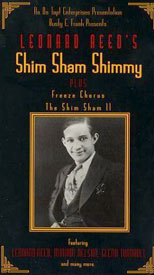 A comedy bit follows with Willie Bryant trying to book Coles & Atkins, with a fast-talking booking agent played by Leonard Reed, who was Willie's regular partner when they did duo stand-up. A comedy bit follows with Willie Bryant trying to book Coles & Atkins, with a fast-talking booking agent played by Leonard Reed, who was Willie's regular partner when they did duo stand-up.
They'd begun doing routines together in the late 1920s when they were song & dance men as well as comics. For Rock 'n' Roll Review, they do only some poor comedy & Leonard's real talents aren't showcased at all.
It's a little hard to believe from this evidence, but they were authentic innovators in their day, & together devised a new kind of tap act later to be much imitated, called "Shim Sham Shimmy" with the swiftest choreography on a number of moves.
It would've been great to see them do if they still had the stamina, but that was something for younger tappers & for their later career they were just comics.
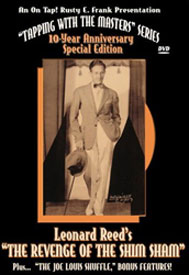 And alas, by the '50s Willie was no longer someone to praise for more than his long history in the business, & Leonard isn't hammy enough to even try to impress. And alas, by the '50s Willie was no longer someone to praise for more than his long history in the business, & Leonard isn't hammy enough to even try to impress.
He really was a talented guy though & too bad the material here is so trivial. He can be seen more impressively on an tap-instruction dvds that include a lot of Lenny, on Leonard Reed's Shim Sham Shimmy (1995), & Leonard Reed's "The Revenge of the Shim Sham" (1999).
These mix of historical footage & Lenny in his 80s & 90s still innovating tap. As instructional videos, Rusty is framing her lessons for advanced tap, & there's just plane how-to about it, nothing artful, providing evidence that "those who can't do, teach."
But the historical clips & love of Leonard Reed make these videos enjoyable to watch even if you have no desire to get up & tap.
Lenny sometimes gets co-credit as director the Studio compilations, as he directed the comedy bits while Joseph Kohn stuck to the Studio telescriptions of musical acts.
Their sketch marks time as we wait for the next & superb Studio Telescription of Dinah Washington singing Only a Moment Ago (1954) & a Snader version of Nat "King" Cole singing the jump-jazz number The Trouble with Me is You (1951).
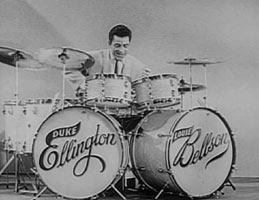 Then Duke Ellington's Snader Telescription for the "bop" swing number instrumental of The Hawk Talks with that amazing Louie Bellson drum solo, & showy Ray Nance trumpet solo. Then Duke Ellington's Snader Telescription for the "bop" swing number instrumental of The Hawk Talks with that amazing Louie Bellson drum solo, & showy Ray Nance trumpet solo.
With a bit more schtick between Willie Bryant & Lenny Reed on the difficulty of the next song's title, another Studio telescription is up next, a great R & B number fully in rock 'n' roll mode, Big Joe Turner's Oki-she-moka-she-pop (1954).
The same Studio telescription was included in Showtime at the Apollo: Variety Time (1955). Joe is backed by the Paul Williams band & a hip sax solo from Frank Foster (Paul plays baritone sax but he remains seated. He's the only guy in a tacky checked jacket).
The same material was also packaged in half-hour bites for television sydnication for a series of half-hour programs called Showtime at the Apollo. Portions of the approximately seventy-five minute feature-length Rock 'n' Roll Review were re-edited as half-hour episodes for the television series Showtime at the Apollo; aka, Harlem Variety Revue. The portion reviewed above formed the episode Showtime at the Apollo: Review in Rhythm (1955), which is in public domain circulation as though it were the entirety of Rock 'n' Roll Review.
The other "Showtime" episode with material also overlapping the longest version of Rock 'n' Roll Review was Showtime at the Apollo: Basin Street Revue (1956), much of the same material also repackaged, respliced, & recombined for video release as Rhythm & Blues at the Apollo Theater (1989).
Scads of references insist these really were shot at athe Apollo Theater, but they weren't. The Snader telescriptions were filmed at California Studios in Los Angeles a few years earlier, & the Studio telescriptions were filmed on the Studio Films soundstage in Manhattan.
Willie really was the emcee at the Apollo Theater, however, & his often-annoying presence in these films helps give the impression that this is a live concert instead of the compilation of individual short-short films. Also, some of the acts filmed in 1954 were indeed booked at the Apollo, & scurried down to Studio Films while they were on Manhattan to make the live recordings of songs they'd also done at the Apollo, so it's not totally a fib.
Included in the Basin Street Review portion are further telescriptions, Dinah Washington, Amos Milboure, Big Joe Turner, Cab Calloway, Ruth Brown, Lionell Hampton, Faye Adams, Martha Davis, Sarah Vaughan, Count Basie, Herb Jeffreys, & Nat King Cole plus comedy schtick with Willie, Nipsy Russell, Mantan Morland, & more of Cole & Atkins.
copyright © by Paghat the Ratgirl
|
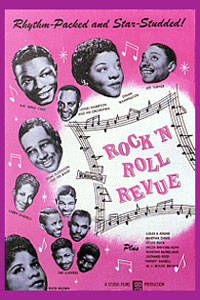

 The first act Willie introduces is Duke Ellington, a Snader telescription of The Mooche (1952; on the original Snader release, the title card mispells this The Mooch). This is a unique arrangement of what was for Duke an often-redone classic instrumental in honor of New Orleans.
The first act Willie introduces is Duke Ellington, a Snader telescription of The Mooche (1952; on the original Snader release, the title card mispells this The Mooch). This is a unique arrangement of what was for Duke an often-redone classic instrumental in honor of New Orleans.
 "Coles & Atkins" are third up, with Paul Williams' combo accompanying Charles "Honi" Coles & Cholly Atkins.
"Coles & Atkins" are third up, with Paul Williams' combo accompanying Charles "Honi" Coles & Cholly Atkins.

 And alas, by the '50s Willie was no longer someone to praise for more than his long history in the business, & Leonard isn't hammy enough to even try to impress.
And alas, by the '50s Willie was no longer someone to praise for more than his long history in the business, & Leonard isn't hammy enough to even try to impress.